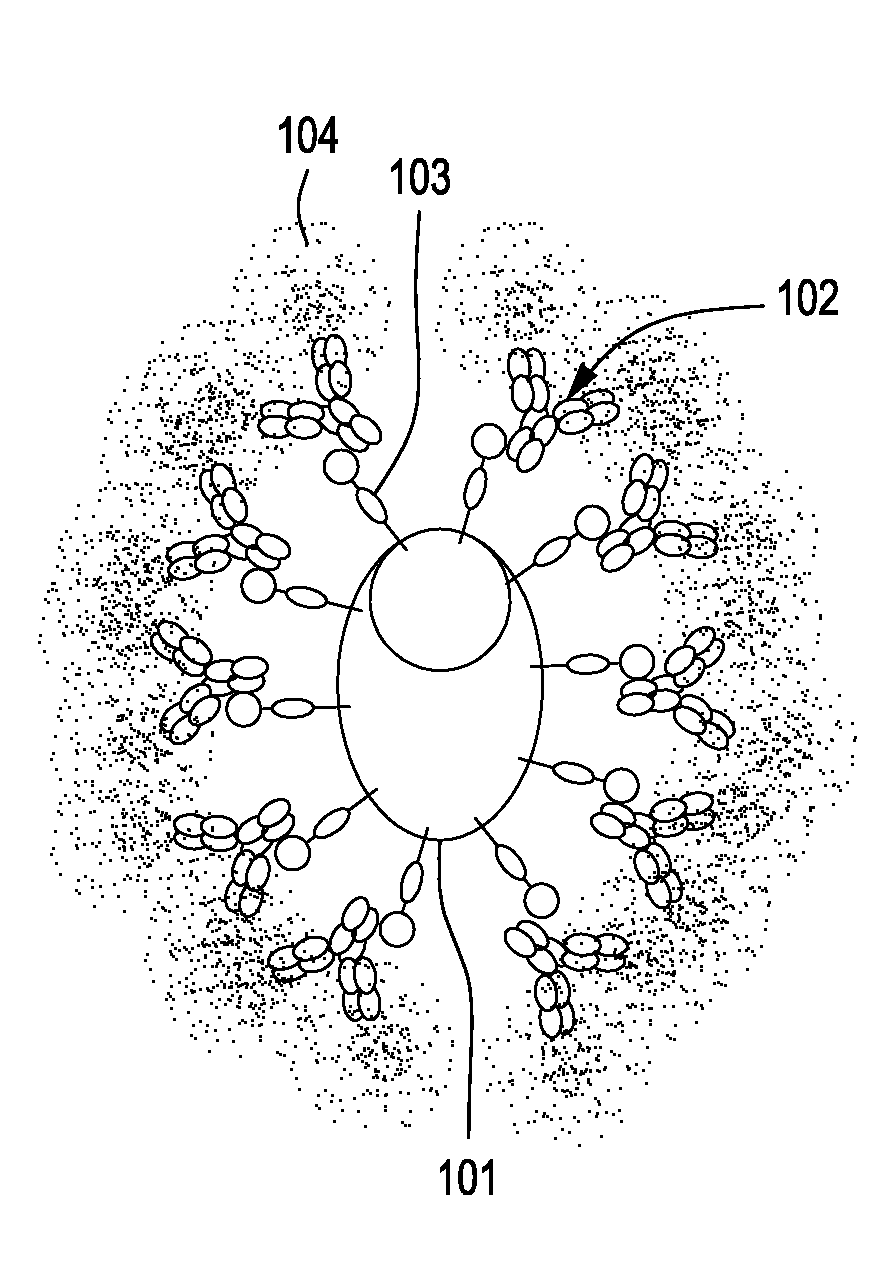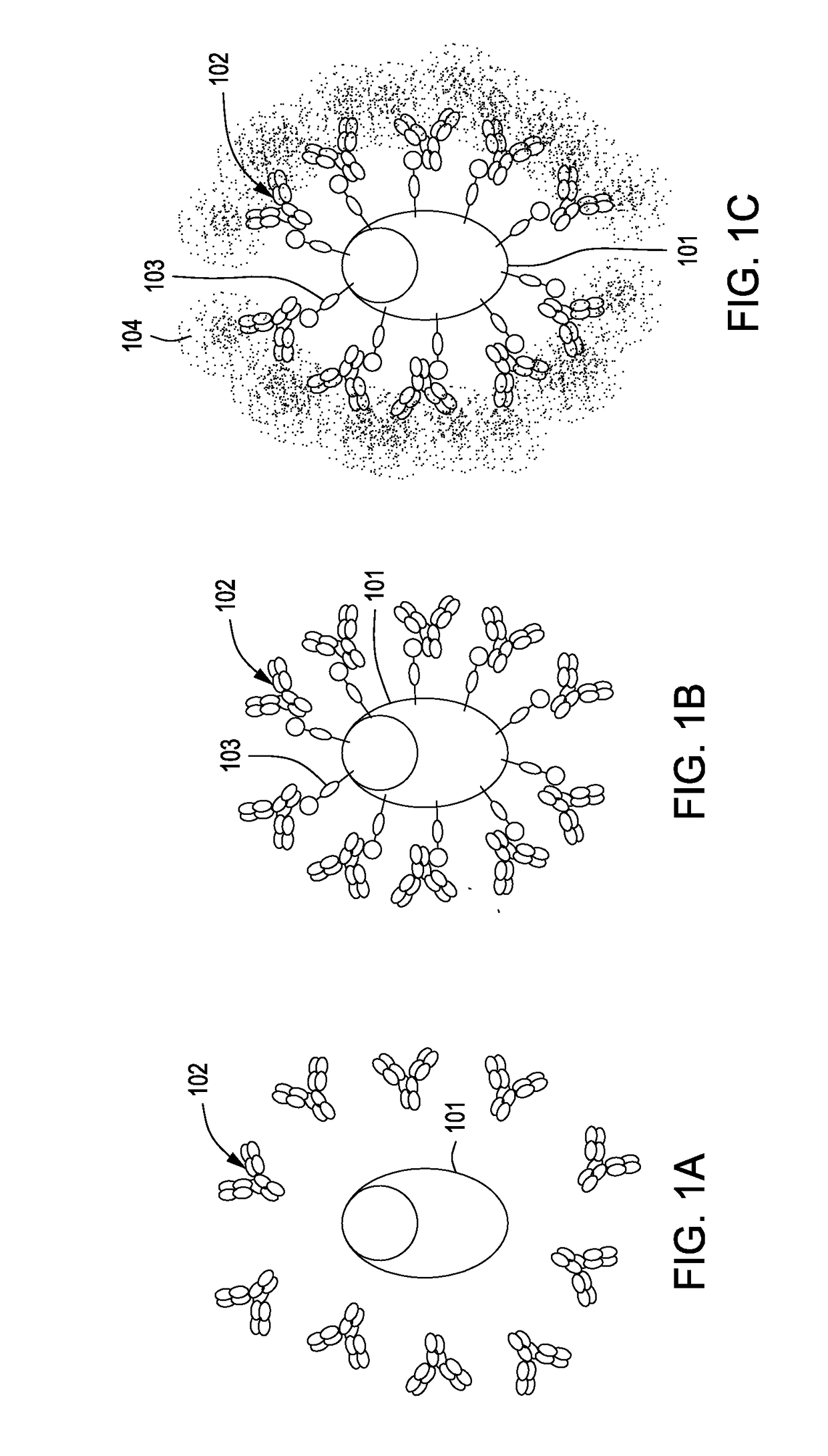Enhanced production of immunoglobulins
- Summary
- Abstract
- Description
- Claims
- Application Information
AI Technical Summary
Benefits of technology
Problems solved by technology
Method used
Image
Examples
example 1
n of a Minimal Protein G-Containing Membrane-Bound Immunoglobulin-Capturing Molecule
[0076]An expression vector encoding a small membrane-bound form of the immunoglobulin-capturing molecule without a stalk is generated by direct DNA synthesis or standard molecular cloning techniques. A diagram of the protein-coding part of this vector (501) is shown in FIG. 5A. The expression vector encodes two immunoglobulin-binding domains of streptococcal Protein G (504) [SEQ ID No. 8] that are tethered to the cell surface by means of a membrane-spanning domain derived the human LAGS (or CD223) protein (506) [SEQ ID No. 17]. A fragment of DNA encoding a short linker consisting of Gly-Ser-Gly-Ser-Gly-Ser sequence (505) [SEQ ID No. 28] is placed between the DNA fragments encoding the Protein G immunoglobulin-binding domains (504) and the transmembrane domain (506) to provide structural flexibility to the expressed protein. Finally, a sequence encoding a signal peptide (leader peptide) (503) is inclu...
example 2
n of a Protein G-Containing Membrane-Bound Immunoglobulin-Capturing Molecule Containing a Stalk
[0080]An expression vector encoding a membrane-bound form of the immunoglobulin-capturing molecule containing a long stalk is generated by direct DNA synthesis or standard molecular cloning techniques. The expression vector encodes three immunoglobulin-binding domains derived from the C-terminal half of streptococcal Protein G [SEQ ID No. 9]. DNA fragments encoding a short linker consisting of Gly-Ser-Gly-Ser-Gly-Ser [SEQ ID No. 28] sequence, a stalk consisting of six immunoglobulin domains derived from human CD22 protein [SEQ ID No. 16], and a transmembrane domain derived from human CD58 [SEQ ID No. 18] are appended to the immunoglobulin-binding domain-encoding DNA fragment of the vector. Finally, a sequence encoding a signal peptide (leader peptide) is placed preceding the entire open-reading frame of the immunoglobulin-capturing molecule to allow for extrusion of the translated protein ...
example 3
n of a Protein G-Containing Immunoglobulin-Capturing Molecule Anchored to the Membrane by a GPI Post-Translational Modification
[0083]An expression vector encoding two immunoglobulin-binding domains derived from the streptococcal Protein G is synthesized. Included in this expression vector downstream of the Protein G-encoding sequence are DNA fragments that encode the following: a Gly / Ser-rich linker sequence, a stalk consisting of two immunoglobulin domains of human CD4, and a GPI anchor sequence. Finally, a signal peptide sequence (leader sequence) is included in the construct to allow for extrusion of the translated protein into the lumen of the endoplasmic reticulum during its biosynthesis. The sequences encoding the signal peptide in this example are derived from an immunoglobulin light chain variable (VL) gene segment and include its native intron. The nucleotide and amino acid sequences of components comprising the immunoglobulin-capturing molecule in this example are specifie...
PUM
| Property | Measurement | Unit |
|---|---|---|
| Current | aaaaa | aaaaa |
| Fraction | aaaaa | aaaaa |
| Surface | aaaaa | aaaaa |
Abstract
Description
Claims
Application Information
 Login to View More
Login to View More - R&D
- Intellectual Property
- Life Sciences
- Materials
- Tech Scout
- Unparalleled Data Quality
- Higher Quality Content
- 60% Fewer Hallucinations
Browse by: Latest US Patents, China's latest patents, Technical Efficacy Thesaurus, Application Domain, Technology Topic, Popular Technical Reports.
© 2025 PatSnap. All rights reserved.Legal|Privacy policy|Modern Slavery Act Transparency Statement|Sitemap|About US| Contact US: help@patsnap.com



